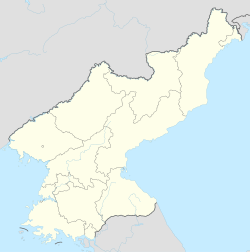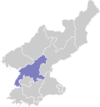|
Kaechon
Kaech'ŏn or Kaechon (US: /ˈɡeɪtʃʌn/ GAY-chun,[1] Korean: [kɛtsʰʌn]; Hangul: 개천시, Hanja: 价川市) is a city in South P'yŏngan province, North Korea. GeographyThe Myohyangsan, Changansan, Ch'ŏnsŏngsan, and Ch'ŏngryongsan mountain ranges come together in Kaech'ŏn. The highest peak is Paekt'apsan. The most important rivers are the Ch'ŏngch'ŏn River and the Taedong River. The area of the city is 61% forested. Administrative divisionsKaech'ŏn-si is divided into 26 tong (neighbourhoods) and 11 ri (villages):
EconomyWater resources are abundant, and several reservoirs are located in Kaech'ŏn. Agriculture has been extensively developed, including livestock and fruit orchards. Machining and metalworking are the dominant industries, mining has also become more prominent. TransportationKaech'ŏn is served by the Korean State Railway's Kaech'ŏn Line and the Manp'o Line trunk lines, as well as the Choyang Colliery Line and Chunhyŏk Line secondary lines. TourismTourist sites in Kaech'ŏn include Songam Cavern, Taeripsa Temple with its 9-level stone pagoda, the fortresses of Changhamsŏng, T'osŏng, and Kosasansŏng, Namsa dolmen, and the group of dolments at Mukpangsan. There are also Yŏnpung Lake, which was constructed in 1956, and Yongwŏn Cavern, which was discovered in 1966 and is preserved as North Korea's Natural Monument No. 43. The Kaechon Revolutionary Site is associated with Kim Il Sung's 250 Mile Journey for National Liberation. A statue was erected there on the occasion of the Day of the Sun, April 15, in 2001.[2] Prison campsThere are two large prison camps in Kaech'ŏn, both known for very harsh conditions:
See alsoNotes
Further reading
External linksWikivoyage has a travel guide for Kaechon.
|
||||||||||||||||||||||||||||||||||||||||||||
Portal di Ensiklopedia Dunia



